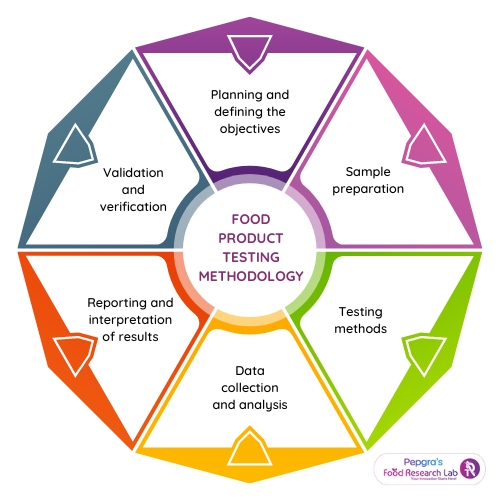
What is a typical methodology for food product testing?
Introduction
Food is a primary requirement for everyone and provides nourishment for leading a healthy life. Therefore, it is crucial that the food we consume is devoid of harmful substances. Stringent testing of food is necessary to ensure that the food is fit for consumption. Hence, it is the responsibility of the food manufacturers to evaluate the products for any contaminants or hazards that affect consumer health. In addition, food product testing brings clarity regarding the composition, enabling consumers to make better food choices and trust the food manufacturing firms. Food testing also makes sure that novel food components and additives are standardised and used at recommended levels [1]. Food product testing has been gaining importance recently and must be tested at every stage, from ingredients to the final product, so that the final product has the best quality.
Food Product testing methodology
The methodology for food product testing in food production can vary depending on the specific type of test being performed and the purpose of the test. However, a typical methodology for food product testing may include the following steps:

Figure 1: Food product testing methodology
Planning and defining the objectives: Before conducting any tests, clearly defining the testing process’s objectives and goals is crucial. This involves identifying the specific characteristics of the food product that must be tested and determining the type of testing required.
Sample preparation: Food samples are collected and prepared for testing. This may involve cutting, grinding, or homogenising the sample with the help of homogenisers, depending on the type of test being conducted. The typical sample types for food product testing are- raw materials, process samples control, finished product, competitor sample and complaint sample.
Testing methods: The specific testing methods used will depend on the test’s objectives and the sample type. Some standard testing methods include sensory testing, chemical analysis, microbiological analysis, and physical testing. For example, nutritional value information for nutrition labelling may require more laborious methods per standardised organisations, while process control samples are analysed by rapid methods [2].
Data collection and analysis: Data is collected during testing and analysed to determine whether the food product meets the desired specifications. This may involve statistical analysis, comparing the test results to industry standards, or using expert judgment to evaluate the results. In addition, the laboratories need to maintain track of the samples and store the data from the analysis in a repository called Laboratory Information Management System (LIMS), which can be accessible to the consumers so they can import, review and analyse as needed [2], [3].
Reporting and interpretation of results: The results of the tests are reported and interpreted to determine whether the food product is acceptable for distribution or sale. Corrective actions may be recommended if the product does not meet the desired specifications.
Validation and verification: Once a food product has been tested and approved, it may be necessary to periodically validate and verify that the product continues to meet the desired specifications. This involves conducting ongoing testing to ensure the product remains safe, high-quality, and meets consumer expectations [2].
Conclusion
Food product testing is crucial to ensure food is safe for human consumption. With increased market competition, the products are also tested for sensory and rheological properties that increase consumer acceptability. The standard methodology includes determining the objective, sample preparation, testing, data collection and analysis, validation and verification.
How the Food Research Lab can help
The Food Research Lab is a contract organisation offering B2B services in food product development. It conducts market research to understand consumer needs and develops a product that could be novel or similar to an existing product or line extension of the company’s products. Tests are conducted in the lab to ensure the product is safe and of the highest quality. It also aids in product marketing and leaves no stone unturned, ensuring the product is successful in the market.





